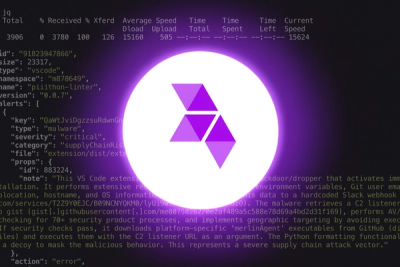
Product
Introducing Webhook Events for Alert Changes
Add real-time Socket webhook events to your workflows to automatically receive software supply chain alert changes in real time.
@tensorflow/tfjs-backend-wasm
Advanced tools
This package adds a WebAssembly backend to TensorFlow.js. It currently supports the following models from our [models](https://github.com/tensorflow/tfjs-models) repo: - BlazeFace - BodyPix - CocoSSD - Face landmarks detection - HandPose - KNN classifier
This package adds a WebAssembly backend to TensorFlow.js. It currently supports the following models from our models repo:
// Import @tensorflow/tfjs or @tensorflow/tfjs-core
import * as tf from '@tensorflow/tfjs';
// Adds the WASM backend to the global backend registry.
import '@tensorflow/tfjs-backend-wasm';
// Set the backend to WASM and wait for the module to be ready.
tf.setBackend('wasm').then(() => main());
<!-- Import @tensorflow/tfjs or @tensorflow/tfjs-core -->
<script src="https://cdn.jsdelivr.net/npm/@tensorflow/tfjs/dist/tf.min.js"> </script>
<!-- Adds the WASM backend to the global backend registry -->
<script src="https://cdn.jsdelivr.net/npm/@tensorflow/tfjs-backend-wasm/dist/tf-backend-wasm.js"></script>
<script>
tf.setBackend('wasm').then(() => main());
</script>
Starting from Chrome 92 (to be released around July 2021), cross-origin isolation needs to be set up in your site in order to take advantage of the multi-threading support in WASM backend. Without this, the backend will fallback to the WASM binary with SIMD-only support (or the vanilla version if SIMD is not enabled). Without multi-threading support, certain models might not achieve the best performance.
Here are the high-level steps to set up the cross-origin isolation. You can learn more about this topic here.
Send the following two HTTP headers when your main document (e.g.index.html) that uses the WASM backend is served. You may need to configure or ask your web host provider to enable these headers.
Cross-Origin-Opener-Policy: same-originCross-Origin-Embedder-Policy: require-corpIf you are loading the WASM backend from jsdelivr through the script tag,
you are good to go. No more steps are needed.
If you are loading the WASM backend from your own or other third-party servers, you need to make sure the script is served with either CORS or CORP header.
CORS header: Access-Control-Allow-Origin: *. In addition, you will also
need to add the "crossorigin" attribute to your script tags.
CORP header:
If the resource is loaded from the same origin as your main site (e.g. main site: mysite.com/, script: mysite.com/script.js), set:
Cross-Origin-Resource-Policy: same-origin
If the resource is loaded from the same site but cross origin (e.g. main site: mysite.com/, script: static.mysite.com:8080/script.js), set:
Cross-Origin-Resource-Policy: same-site
If the resource is loaded from the cross origin(s) (e.g. main site: mysite.com/, script: mystatic.com/script.js), set:
Cross-Origin-Resource-Policy: cross-origin
If the steps above are correctly done, you can check the Network tab from the
console and make sure the
tfjs-backend-wasm-threaded-simd.wasm WASM binary is loaded.
By default, the backend will use the number of logical CPU cores as the
threads count when creating the threadpool used by XNNPACK. You can use the
setThreadsCount API to manually set it (must be called before calling
tf.setBackend('wasm')). getThreadsCount API can be used to get the actual
number of threads being used (must be called after the WASM backend is
initialized).
import * as tf from '@tensorflow/tfjs';
import {getThreadsCount, setThreadsCount} from '@tensorflow/tfjs-backend-wasm';
setThreadsCount(2);
tf.setBackend('wasm').then(() => {
console.log(getThreadsCount());
});
tf.wasm.setThreadsCount(2);
tf.setBackend('wasm').then(() => {
console.log(tf.wasm.getThreadsCount());
});
async function main() {
let img = tf.browser.fromPixels(document.getElementById('img'))
.resizeBilinear([224, 224])
.expandDims(0)
.toFloat();
let model = await tf.loadGraphModel(
'https://tfhub.dev/google/imagenet/mobilenet_v2_100_224/classification/2',
{fromTFHub: true});
const y = model.predict(img);
y.print();
}
main();
Our WASM backend builds on top of the XNNPACK library which provides high-efficiency floating-point neural network inference operators.
The shipped library on NPM consists of 2 files:
dist/tfjs-backend-wasm.wasmThere is a proposal to add
WASM support for ES6 modules. In the meantime, we have to manually read the wasm
file. When the WASM backend is initialized, we make a fetch/readFile
for tfjs-backend-wasm.wasm relative from the main js file. This means that
bundlers such as Parcel and WebPack need to be able to serve the .wasm file in
production. See starter/parcel and
starter/webpack for how to setup your favorite bundler.
If you are serving the .wasm files from a different directory, call
setWasmPaths with the location of that directory before you initialize the
backend:
import {setWasmPaths} from '@tensorflow/tfjs-backend-wasm';
// setWasmPaths accepts a `prefixOrFileMap` argument which can be either a
// string or an object. If passing in a string, this indicates the path to
// the directory where your WASM binaries are located.
setWasmPaths('www.yourdomain.com/');
tf.setBackend('wasm').then(() => {...});
If the WASM backend is imported through <script> tag, setWasmPaths needs to
be called on the tf.wasm object:
tf.wasm.setWasmPaths('www.yourdomain.com/');
Note that if you call setWasmPaths with a string, it will be used to load
each binary (SIMD-enabled, threading-enabled, etc.) Alternatively you can specify
overrides for individual WASM binaries via a file map object. This is also helpful
in case your binaries have been renamed.
For example:
import {setWasmPaths} from '@tensorflow/tfjs-backend-wasm';
setWasmPaths({
'tfjs-backend-wasm.wasm': 'www.yourdomain.com/renamed.wasm',
'tfjs-backend-wasm-simd.wasm': 'www.yourdomain.com/renamed-simd.wasm',
'tfjs-backend-wasm-threaded-simd.wasm': 'www.yourdomain.com/renamed-threaded-simd.wasm'
});
tf.setBackend('wasm').then(() => {...});
If you are using a platform that does not support fetch directly, please set the
optional usePlatformFetch argument to true:
import {setWasmPath} from '@tensorflow/tfjs-backend-wasm';
const usePlatformFetch = true;
setWasmPaths(yourCustomPathPrefix, usePlatformFetch);
tf.setBackend('wasm').then(() => {...});
If your bundler is capable of minifying JS code, please turn off the option
that transforms typeof foo == "undefined" into foo === void 0. For
example, in terser, the option is called
"typeofs" (located under the
Compress options section).
Without this feature turned off, the minified code will throw "_scriptDir is not
defined" error from web workers when running in browsers with
SIMD+multi-threading support.
If you see the Cannot find name 'EmscriptenModule' error when building your
Angular app, make sure to add "@types/emscripten" to the
compilerOptions.types field in your tsconfig.app.json (or tsconfig.json):
{
...
"compilerOptions": {
"types": [
"@types/emscripten"
]
},
...
}
By default, the generated Angular app sets this field to an empty array
which will prevent the Angular compiler from automatically adding
"global types" (such as EmscriptenModule) defined in d.ts files to your app.
The benchmarks below show inference times (ms) for two different edge-friendly models: MobileNet V2 (a medium-sized model) and Face Detector (a lite model). All the benchmarks were run in Chrome 79.0 using this benchmark page across our three backends: Plain JS (CPU), WebGL and WASM. Inference times are averaged across 200 runs.
MobileNet is a medium-sized model with 3.48M params and ~300M multiply-adds. For this model, the WASM backend is between ~3X-11.5X faster than the plain JS backend, and ~5.3-7.7X slower than the WebGL backend.

| MobileNet inference (ms) | WASM | WebGL | Plain JS | WASM + SIMD | WASM + SIMD + threads |
|---|---|---|---|---|---|
| iPhone X | 147.1 | 20.3 | 941.3 | N/A | N/A |
| iPhone XS | 140 | 18.1 | 426.4 | N/A | N/A |
| Pixel 4 | 182 | 76.4 | 1628 | 82 | N/A |
| ThinkPad X1 Gen6 w/Linux | 122.7 | 44.8 | 1489.4 | 34.6 | 12.4 |
| Desktop Windows | 123.1 | 41.6 | 1117 | 37.2 | N/A |
| Macbook Pro 15 2019 | 98.4 | 19.6 | 893.5 | 30.2 | 10.3 |
| Node v.14 on Macbook Pro | 290 | N/A | 1404.3 | 64.2 | N/A |
Face detector is a lite model with 0.1M params and ~20M multiply-adds. For this model, the WASM backend is between ~8.2-19.8X faster than the plain JS backend and comparable to the WebGL backend (up to ~1.7X faster, or 2X slower, depending on the device).

| Face Detector inference (ms) | WASM | WebGL | Plain JS | WASM + SIMD | WASM + SIMD + threads |
|---|---|---|---|---|---|
| iPhone X | 22.4 | 13.5 | 318 | N/A | N/A |
| iPhone XS | 21.4 | 10.5 | 176.9 | N/A | N/A |
| Pixel 4 | 28 | 28 | 368 | 15.9 | N/A |
| Desktop Linux | 12.6 | 12.7 | 249.5 | 8.0 | 6.2 |
| Desktop Windows | 16.2 | 7.1 | 270.9 | 7.5 | N/A |
| Macbook Pro 15 2019 | 13.6 | 22.7 | 209.1 | 7.9 | 4.0 |
You should always try to use the WASM backend over the plain JS backend since it is strictly faster on all devices, across all model sizes. Compared to the WebGL backend, the WASM backend has better numerical stability, and wider device support. Performance-wise, our benchmarks show that:
We are committed to supporting the WASM backend and will continue to improve performance. We plan to follow the WebAssembly standard closely and benefit from its upcoming features such as multi-threading.
See register_all_kernels.ts
for an up-to-date list of supported ops. We love contributions. See the
contributing
document for more info.
Maybe. There are still a decent number of ops that we are missing in WASM that are needed for gradient computation. At this point we are focused on making inference as fast as possible.
Yes. If you run into issues, please let us know.
Yes. We take advantage of SIMD and multi-threading wherever they are supported by testing the capabilities of your runtime and loading the appropriate WASM binary. If you intend to serve the WASM binaries from a custom location (via setWasmPaths), please note that the SIMD-enabled and threading-enabled binaries are separate from the regular binary.
We'd love your feedback as we develop this backend! Please file an issue here.
The Emscripten installation necessary to build the WASM backend is managed automatically by the Bazel Emscripten Toolchain.
yarn build
yarn test
./scripts/build-npm.sh
npm publish
FAQs
This package adds a WebAssembly backend to TensorFlow.js. It currently supports the following models from our [models](https://github.com/tensorflow/tfjs-models) repo: - BlazeFace - BodyPix - CocoSSD - Face landmarks detection - HandPose - KNN classifier
We found that @tensorflow/tfjs-backend-wasm demonstrated a not healthy version release cadence and project activity because the last version was released a year ago. It has 10 open source maintainers collaborating on the project.
Did you know?

Socket for GitHub automatically highlights issues in each pull request and monitors the health of all your open source dependencies. Discover the contents of your packages and block harmful activity before you install or update your dependencies.

Product
Add real-time Socket webhook events to your workflows to automatically receive software supply chain alert changes in real time.

Security News
ENISA has become a CVE Program Root, giving the EU a central authority for coordinating vulnerability reporting, disclosure, and cross-border response.

Product
Socket now scans OpenVSX extensions, giving teams early detection of risky behaviors, hidden capabilities, and supply chain threats in developer tools.